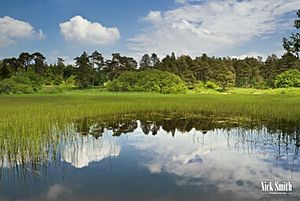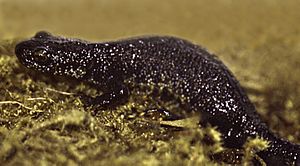Priddy Pools facts for kids
| Site of Special Scientific Interest | |
| Area of Search | Somerset |
|---|---|
| Coordinates | 51°15′23″N 2°39′12″W / 51.25634°N 2.65340°W |
| Interest | Biological and Geological |
| Area | 52.7 ha (130 acres) |
| Notification | 1972 |
Priddy Pools is a special place in the Mendip Hills, Somerset, England. It covers about 52.7 hectares, which is like 130 football fields! This area is known as a Site of Special Scientific Interest (SSSI). It was given this important title in 1972 because of its amazing plants, animals, and unique geology.
Long ago, the pools here helped supply water for the Priddy Mineries. This was a place where lead was mined. Today, the old mining area is a Nature Reserve, protecting the local wildlife.
Contents
Wonderful Wildlife at Priddy Pools
Priddy Pools is home to many different kinds of animals, especially small creatures without backbones (invertebrates) and amphibians. Amphibians are animals like frogs and newts that can live both on land and in water.
The area has many types of natural habitats. These include wet, boggy areas called valley mires, open water, and swampy lands. These kinds of habitats are rare in the Mendip Hills.
How Lead Mining Shaped the Land
Priddy Pools is located in an area where lead was mined a long time ago. This mining has changed the environment. For example, one of the northern pools was dammed in the 1850s. This was done to get water for washing and sifting lead ore. Lead was processed here until 1908.
Water flows in a complex way at Priddy Pools. Clean water comes from springs in the north. It then flows into a cave entrance called St Cuthbert's Swallet. From there, the water goes underground and reappears at Wookey Hole, a famous cave system.
Plants That Love Lead
In the wet areas near the springs, you can find a special type of bog called a valley mire. Here, you'll see different kinds of mosses, like Sphagnum recurvum and Sphagnum auriculatum.
Some plants at Priddy Pools are very special because they can grow in soil with high levels of lead. These include the spring sandwort and a moss called Ditrichum plumbicola.
Amazing Animals of the Pools
Priddy Pools is full of life! You can find fifteen different types of dragonfly here. It's the only place in the Mendips where you can see the downy emerald dragonfly. Other cool dragonflies include the four-spotted chaser and the ruddy darter.
The site is also home to five types of amphibians found in Britain. There are many great crested newts, smooth newts, and palmate newts.
You might also spot three types of reptiles: the viviparous lizard, the adder (a type of snake), and the grass snake. In the water, there are fish like European perch and three-spined stickleback.
Many birds also live and breed here. These include the moorhen, coot, mallard, reed bunting, and sedge warbler.
Scientists have studied Priddy Pools for a long time. For example, detailed research on the tiny algae in the northern pool was done in the late 1960s and early 1970s.
Exploring the Caves Below Priddy Pools
Priddy Pools is not just interesting above ground; it's also amazing underground! The site sits above a huge cave system. The entrance to St Cuthbert's Swallet cave is right here.
The Priddy Caves System
The Priddy Caves system is enormous, with over 16 kilometers (10 miles) of explored passages. These passages are divided into several smaller systems, but they are all connected.
These caves are "sink hole" systems. This means water from the surface flows down into holes in the ground, creating the caves. Three of these caves are deeper than 100 meters! In all the caves, you can clearly see how the water followed natural cracks and weaknesses in the rocks to form the passages.
How St Cuthbert's Swallet Was Formed
St Cuthbert's Swallet is a great example of a deep cave system. It was formed by water flowing deep underground, where the rock was completely filled with water. This process is called "phreatic development."
The cave has many levels of slanted passages and huge rooms. Scientists have found evidence of nine different stages of change in St Cuthbert's Swallet. These include times when mud and sand were deposited, when stalagmites grew, and when streams eroded the rock. This provides an amazing record of how the environment changed during the warm and cold periods of the Ice Age.



